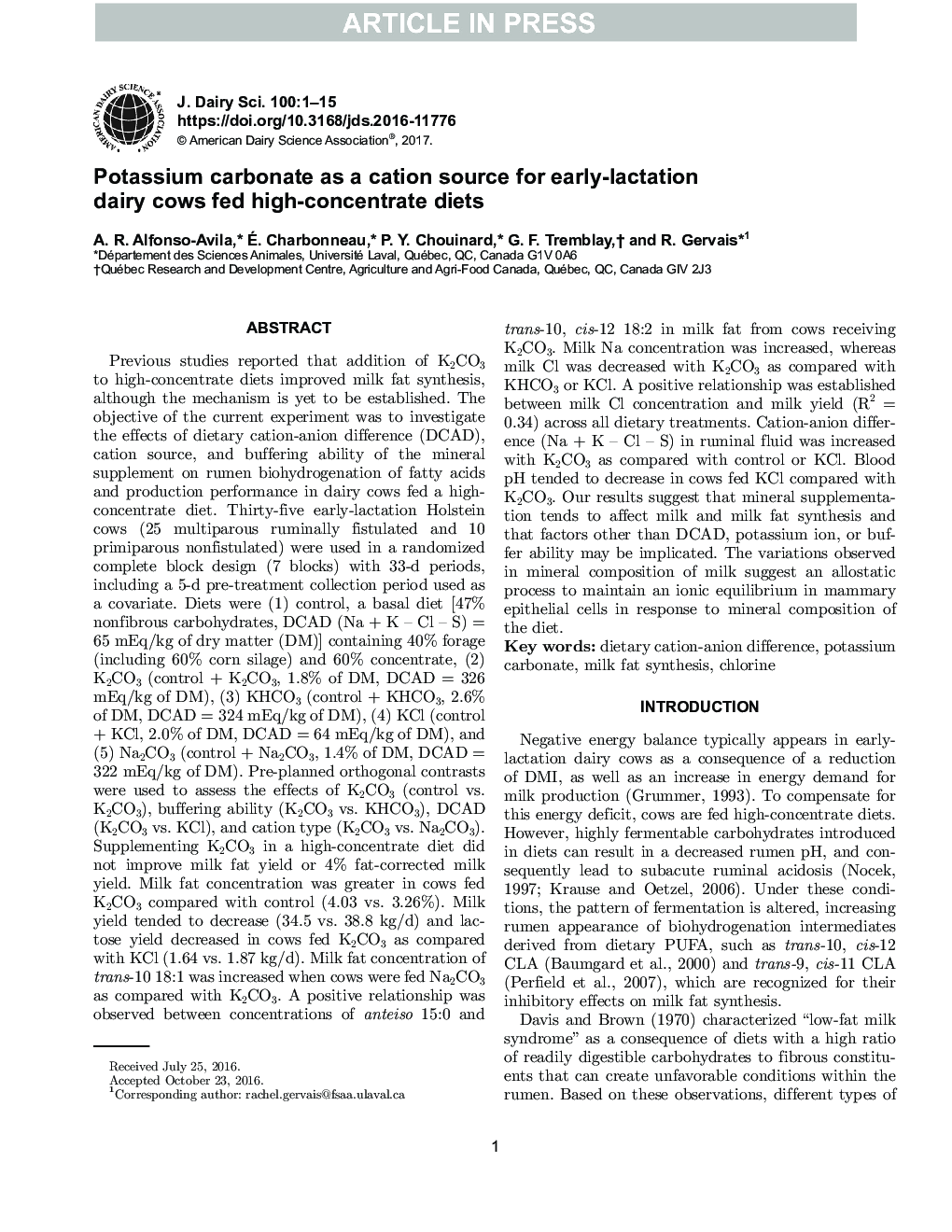| کد مقاله | کد نشریه | سال انتشار | مقاله انگلیسی | نسخه تمام متن |
|---|---|---|---|---|
| 5542484 | 1402519 | 2017 | 15 صفحه PDF | دانلود رایگان |
عنوان انگلیسی مقاله ISI
Potassium carbonate as a cation source for early-lactation dairy cows fed high-concentrate diets
ترجمه فارسی عنوان
کربنات پتاسیم به عنوان منبع کاتیونی برای گاوهای شیرده زودرس تغذیه با رژیم های حاوی کنسانتره بالا
دانلود مقاله + سفارش ترجمه
دانلود مقاله ISI انگلیسی
رایگان برای ایرانیان
کلمات کلیدی
اختلاف کیتی-آنیونی در رژیم غذایی، کربنات پتاسیم، سنتز چربی شیر، کلر،
موضوعات مرتبط
علوم زیستی و بیوفناوری
علوم کشاورزی و بیولوژیک
علوم دامی و جانورشناسی
چکیده انگلیسی
Previous studies reported that addition of K2CO3 to high-concentrate diets improved milk fat synthesis, although the mechanism is yet to be established. The objective of the current experiment was to investigate the effects of dietary cation-anion difference (DCAD), cation source, and buffering ability of the mineral supplement on rumen biohydrogenation of fatty acids and production performance in dairy cows fed a high-concentrate diet. Thirty-five early-lactation Holstein cows (25 multiparous ruminally fistulated and 10 primiparous nonfistulated) were used in a randomized complete block design (7 blocks) with 33-d periods, including a 5-d pre-treatment collection period used as a covariate. Diets were (1) control, a basal diet [47% nonfibrous carbohydrates, DCAD (Na + K - Cl - S) = 65 mEq/kg of dry matter (DM)] containing 40% forage (including 60% corn silage) and 60% concentrate, (2) K2CO3 (control + K2CO3, 1.8% of DM, DCAD = 326 mEq/kg of DM), (3) KHCO3 (control + KHCO3, 2.6% of DM, DCAD = 324 mEq/kg of DM), (4) KCl (control + KCl, 2.0% of DM, DCAD = 64 mEq/kg of DM), and (5) Na2CO3 (control + Na2CO3, 1.4% of DM, DCAD = 322 mEq/kg of DM). Pre-planned orthogonal contrasts were used to assess the effects of K2CO3 (control vs. K2CO3), buffering ability (K2CO3 vs. KHCO3), DCAD (K2CO3 vs. KCl), and cation type (K2CO3 vs. Na2CO3). Supplementing K2CO3 in a high-concentrate diet did not improve milk fat yield or 4% fat-corrected milk yield. Milk fat concentration was greater in cows fed K2CO3 compared with control (4.03 vs. 3.26%). Milk yield tended to decrease (34.5 vs. 38.8 kg/d) and lactose yield decreased in cows fed K2CO3 as compared with KCl (1.64 vs. 1.87 kg/d). Milk fat concentration of trans-10 18:1 was increased when cows were fed Na2CO3 as compared with K2CO3. A positive relationship was observed between concentrations of anteiso 15:0 and trans-10,cis-12 18:2 in milk fat from cows receiving K2CO3. Milk Na concentration was increased, whereas milk Cl was decreased with K2CO3 as compared with KHCO3 or KCl. A positive relationship was established between milk Cl concentration and milk yield (R2 = 0.34) across all dietary treatments. Cation-anion difference (Na + K - Cl - S) in ruminal fluid was increased with K2CO3 as compared with control or KCl. Blood pH tended to decrease in cows fed KCl compared with K2CO3. Our results suggest that mineral supplementation tends to affect milk and milk fat synthesis and that factors other than DCAD, potassium ion, or buffer ability may be implicated. The variations observed in mineral composition of milk suggest an allostatic process to maintain an ionic equilibrium in mammary epithelial cells in response to mineral composition of the diet.
ناشر
Database: Elsevier - ScienceDirect (ساینس دایرکت)
Journal: Journal of Dairy Science - Volume 100, Issue 3, March 2017, Pages 1751-1765
Journal: Journal of Dairy Science - Volume 100, Issue 3, March 2017, Pages 1751-1765
نویسندگان
A.R. Alfonso-Avila, Ã. Charbonneau, P.Y. Chouinard, G.F. Tremblay, R. Gervais,
